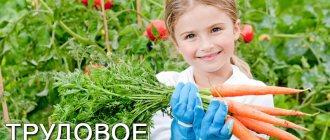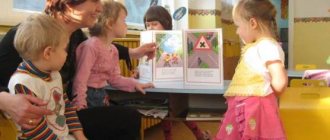MAGAZINE Preschooler.RF
Consultation for educators: “The role of the educator in the environmental education of a preschool child.”Teacher Esina Marina Aleksandrovna
MBDOU kindergarten "Belochka" Tambov, Tambov region.
When a child communicates with nature, a contradiction often arises. On the one hand, they are very interested in plants and animals, they love them, on the other hand, they show cruelty and indifference. Thus, children tear off the wings of insects and tear apart earthworms. Because of a momentary whim, children break branches of trees and bushes, tear them in armfuls and then, without regret, throw away flowering plants and trample lawns. At the same time, children do not regard their actions as a manifestation of evil.
Why is this happening? This is due, first of all, to preschoolers’ ignorance of the rules of interaction with natural objects.
On their own, it is difficult for preschoolers to see, for example, the manifestation of plant life, to understand that they, like other living beings, breathe, eat, move, and reproduce.
Therefore, adults come to the child’s aid, and in kindergarten, of course, a teacher who will help the child understand all the diversity of the world around him.
I would like to share the experience of my work in this direction, namely, what I did so that interaction with nature contributed to the formation of a friendly and correct attitude towards it in a preschooler.
Firstly, she tried to be a bearer of ecological culture and, through her behavior and actions, created a model of interaction with nature, a caring attitude towards it, and demonstrated the necessity and significance of everything that happens in front of children.
Secondly, she taught children to empathize and instilled in them an emotionally positive attitude towards nature. After all, emotions play a big role in the perception of nature, its beauty and uniqueness, as well as in showing sympathy for those who are in trouble, and a child is, as it were, “charged” with our emotions. Therefore, every time, at any opportunity, I admired natural objects and phenomena, found even the most unsightly, at first glance, object of nature and admired it. For example: I was surprised at the blue sky, white clouds and bright stars, a beautiful moth and a long worm, grass breaking through the asphalt, etc. She admired the good deeds of people, felt joy from the well-being of a living being and tried to “infect” children with this. Whenever possible, she always inserted a poetic word, and a poetic word will always leave an indelible mark in the heart of a child.
Thirdly, in no case should it be allowed that a child’s interaction with nature has a negative connotation.
And if an adult does not pay attention to this, children get used to dividing natural objects into beautiful and ugly, necessary and unnecessary, and build their attitude towards them accordingly. As a result, instead of accumulating positive emotions - surprise (for example, how interestingly a grasshopper has adapted to its environment), empathy (for example, a bug in trouble) - the child gains the experience of an indifferent or even heartless attitude towards objects that, in his opinion, are unpleasant.
The next point is introducing children to work.
Work activity must be regular. It is important for the teacher to introduce every child to it, since work in a corner of nature or in a kindergarten area contributes to the development of children’s powers of observation and curiosity, inquisitiveness, and arouses their interest in objects of nature and human labor.
In the process of working in nature, children develop knowledge about plants and animals (appearance, needs, methods of movement, habits, lifestyle, seasonal changes). Children learn to make connections between conditions, the way of life of an animal in nature and ways to care for it in a corner of nature.
When implementing environmental education, I tried to follow an integrated approach, which involves the interconnection of research activities, modeling, music, visual arts, physical education, games, theatrical activities, etc. It is this approach, in my opinion, that greens various types of child activities.
Working with parents.
A noticeable influence on the upbringing of a child is exerted by the way, level, quality and style of life of the family. Children are very sensitive to what they see around them. They behave like the adults around them.
Parents must realize that they cannot demand that their child follow any rule of behavior if adults themselves do not always follow it. For example, it is difficult to explain to children that they need to protect nature if the parents do not do this themselves. And the different demands made in kindergarten and at home can cause them confusion, resentment, or even aggression.
I work with parents in the form of meetings (general and group) in order to inform parents about joint work and stimulate their active participation in it. I invite them to classes, post a lot of visual material, and publish booklets on the topic of taking care of and protecting nature.
Now let's consider the question: how should this activity be organized in different age groups in order to realize its leading motive - the education of preschoolers in the principles of environmental culture - and achieve specific goals?
At early preschool age, children in joint activities are more observers than practical performers, and yet it is at this age that the pattern of interaction with nature is decisive: children hear and absorb the gentle conversation of an adult with animals and plants, calm and clear explanations about , what and how to do, they see the actions of the teacher and willingly take part in them. For example, having invited children to participate in watering indoor plants, the teacher says something like this: “Let's go to the window, look at our plants, talk to them and water them. (We went to the window.) Hello, flowers! How are you feeling? Are they not frozen or dry? (Examines the plants.) No, everything is fine - you are green and beautiful. Look how good our plants are, how nice it is to look at them! (Touches the soil in the pot.) Dry soil, but plants need water - they are alive, they cannot live without water! . " The teacher gives each child a watering can with a little water in it, waters everything himself, saying: “Ogonyok, we will pour a lot of water into your pot, drink as much as you want and continue to grow - we will admire you!” Children's participation in this joint activity consists of listening to the teacher's speech, observing his actions, holding watering cans, giving and receiving them, together filling them with water and putting them in place. The teacher takes care of the plants in front of the children and together with them - this is an example of interaction with nature. Learning as a didactic task is not in the foreground; it occurs by itself, naturally in the process of joint practical activity.
In the middle group, the teacher and children act together, although priority belongs to the adult, which is expressed in the formula: “I do - you help me, you are my assistants. We take care of our pets together!”
In older preschool age, children's independence rapidly increases, and it becomes possible for them to be on duty in a corner of nature. The adult and children change roles: the children do everything necessary themselves, and the teacher helps them (it doesn’t matter that the help at first can be very large). The teacher makes sure to note all the children’s achievements and praise them for their independence, confidence and initiative. Teachers who do everything themselves and do not give preschoolers the opportunity to observe and participate in creating normal conditions for the inhabitants of living corners, nature rooms, plots, develop in children indifference, callousness and inattention in general to life as a unique value.
These, in my opinion, are the basic conditions that are necessary for the environmental education of children.
| Next > |




